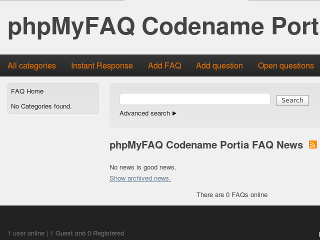
phpMyFAQ
phpMyFAQ is a multilingual, completely database-driven FAQ-system. It supports various databases to store all data, PHP 5.2 (or higher) is needed in order to access this data. phpMyFAQ also offers a multi-language Content Management-System with a WYSIWYG editor and an Image Manager, flexible multi-user support with user and group based permissions on categories and records, a wiki-like revision feature, a news system, user-tracking, language modules, enhanced automatic content negotiation, templates, extensive XML-support, PDF-support, a backup-system, a dynamic sitemap, related articles, tagging, RSS feeds, built-in spam protection systems, LDAP support, and an easy to use installation script.
phpMyFAQ offers the following features:
- Various supported database systems - MySQL (libmysql and mysqlnd), PostgreSQL, SQLite, Sybase, MS SQL Server, IBM DB2, IBM Cloudscape, Apache Derby, Oracle, Interbase, or Firebird.
- Content Management System - You can administrate your users, groups, news, categories, FAQ records, comments, glossary items, and stop words in the password protected admin area.
- User and group based permissions - You can assign permissions to users and groups, you can create users and user groups with permissions and category and even record restrictions for viewing and creating/editing content.
- LDAP and HTTP authentication - Add your company's LDAP based user management into phpMyFAQ for authentication or just secure your whole FAQ by using HTTP authentication.
- Active Directory support - phpMyFAQ supports LDAP-datamapping, e.g. against an Active Directory Server, including multi-domain-authentication, e.g. against an ADS-Global Catalog.
- Revision system - Store the old entries in wiki-like revisions, so you can switch back to old versions of the FAQ entry.
- Community modules - All users can write questions to the system, so that other user can answer these questions. They can also answer these open questions or add translations for existing FAQ records. All these user-generated entries have to be enabled by the administrators.
- FAQ statistics - Analyze the way of your users through your FAQ with the built-in user tracking, analyze the quality of your records with the statistics of the user votings and the number of views on each record.
- Backup and Restore - Backup and restore all the database content with one click.
- Templating system - You can easily customize your version of phpMyFAQ to your layout by using XHTML and CSS.
- Powerful search - Your users can easily find questions and answers using the search feature with search in all languages or in one category. Using the Instant Response frontend your users will find questions and answers while they are typing like in Google Suggest! You'll also get a list of the most popular searches and you get a graphical report about the search in the administration backend.
- OpenSearch and Microsummaries support - Search through your FAQ using the internal Firefox 2+ or IE7+ search. You can also use Microsummaries in Firefox 3+.
- User comments - Get more feeback by your users and visitors, by allowing them to comment on your questions and answers.
- Smart answering - If an user submits a new question, phpMyFAQ will automaticallyy try to answer the question by doing a full text search on all existing FAQs.
- Easy to use HTML editor - Add your FAQ entries using the integrated WYSIWYG (What You See Is What You Get) HTML editor based on TinyMCE and create rich text, links, lists directly through your web browser. Your links will also be automatically verfified during saving your new FAQ record. The Ajax-powered Image Manager provides an web interface to browse for image files (JPEG, PNG, GIF, and others) on the web server.
- Multilanguage support - phpMyFAQ supports more than 35 UTF-8 encoded languages and has an extended right-to-left support even for the whole layout for Arabic, Farsi and Hebrew. You can also add missing translation in the administration backend for your language and you can send your improved translations to the phpMyFAQ Team.
- Most popular FAQs, latest FAQs, and sticky FAQs - The start page of the public area shows an automatically created list with he most popular records and of the latest FAQ entries. You can also define "sticky" FAQs which always appear on the main FAQ page. The sticky FAQs are also the first ones in the category FAQ lists. The most popular and the latest FAQs are also available as RSS feeds.
- Browse by Category or Tags - You can create unlimited categories and subcategories for your FAQs. Your users can browse through the categories. You can tag all records and an automatically generated tag cloud helps your users, too.
- Search engine optimization - Support for Apache mod_rewrite, IIS ISAPI_rewrite, and lighttpd mod_rewrite.
- Extended sitemap support - Lists all FAQ articles in a alphabetical order. We also support special automatically generated sitempas for Google, MSN, and Yahoo! search robots!
- Simple installation and configuration - Install and set up your FAQ only with your browser!
- Exports your FAQ - PDF, XHTML, and plain XML
- Advanced spam protection - phpMyFAQ uses captchas, bad word lists and IP ban lists to prevent spam.

| Home Page | phpMyFAQ |
| Version | 2.8.22 |
| Contributor | bigfoot65 |
| Updated | about 7 years ago |
| Tags | guide, faq, kb, tips, hints |
| Share | |
| Status |
|
Want to add your own app or package your favorite app here? Become a contributor and submit apps!